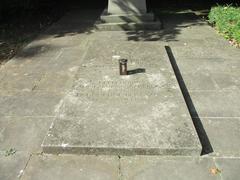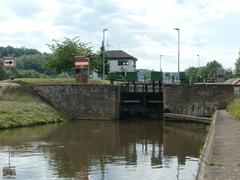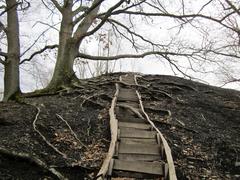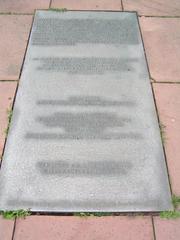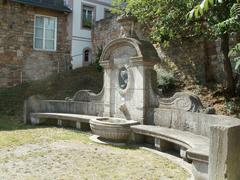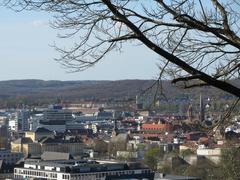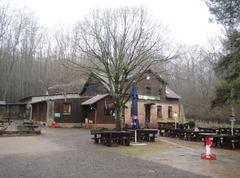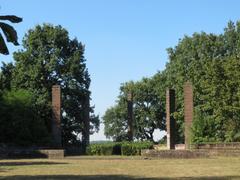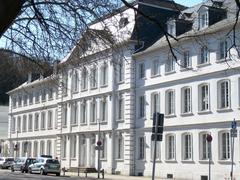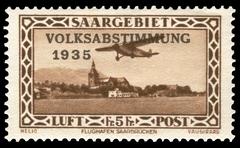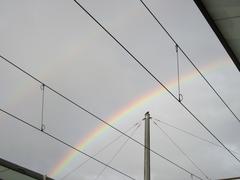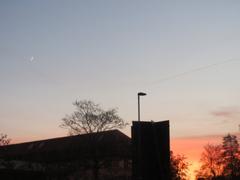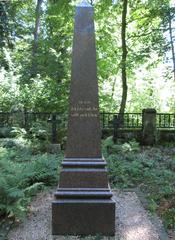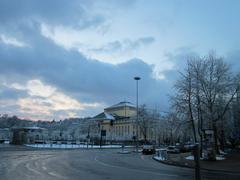Telemachos-Figur Saarbrücken: Visiting Hours, Tickets & Historical Sites Guide
Date: 14/06/2025
Introduction
The Telemachos-Figur is an iconic public sculpture in the heart of Saarbrücken, Germany, offering a compelling blend of mythological meaning, artistic vision, and cultural engagement. Set in front of the St. Johann Town Hall at Rathausplatz, this striking bronze statue by Ludwig Cauer has become a symbol of Saarbrücken’s evolving identity, reflecting both classical roots and contemporary urban life. As you explore Saarbrücken’s historic core—marked by German and French influences—you’ll find the Telemachos-Figur at a crossroads of art, history, and community (Saarbrücken Wikivoyage; Saarbrücken Town Hall History).
This detailed guide covers everything you need for a rewarding visit: the historical context and artistic significance of the Telemachos-Figur, practical visitor information (hours, tickets, accessibility), guided tours, and a curated selection of nearby attractions. Whether you’re an art lover, history enthusiast, or a curious traveler, the Telemachos-Figur is a must-see landmark among Saarbrücken’s historical sites.
Table of Contents
- Historical Context of the Telemachos-Figur
- Artistic Significance
- Visitor Information
- Nearby Attractions
- FAQs
- Conclusion & Travel Recommendations
- Sources & Further Reading
Historical Context of the Telemachos-Figur
Saarbrücken’s Artistic Landscape
Saarbrücken’s public art tradition is a product of its unique location at the crossroads of German and French culture. The city’s commitment to accessible urban art is exemplified by the Telemachos-Figur, which stands as both a historical reference and a dynamic element in the city’s cultural narrative (Saarbrücken Wikivoyage).
Mythological Roots: Telemachos in Antiquity
Telemachos, son of Odysseus and Penelope from Homer’s Odyssey, embodies themes of identity, coming of age, and the search for truth. The sculpture’s presence in Saarbrücken creates a link between the city’s present and universal human experiences, resonating with its history of migration, renewal, and transformation.
Commissioning, Installation, and Artistic Vision
Ludwig Cauer created the Telemachos-Figur in the late 19th century, interpreting the mythological youth with a posture that conveys both vulnerability and resolve. The statue originally topped a decorative fountain donated by Emil Haldy. While the fountain has changed over time, the bronze figure remains a focal point of Rathausplatz (Komoot Highlight). The choice of Telemachos and Cauer’s narrative approach align with modern trends in public art, which prioritize emotional engagement and storytelling (Saarbrücken Sehenswürdigkeiten).
Artistic Significance
Materiality and Technique
The Telemachos-Figur is crafted in bronze, giving it durability and allowing for intricate detail. Its life-sized scale and realistic texture invite close inspection and foster empathy in viewers.
Symbolism and Community Impact
- Journey Motif: The figure’s contemplative pose captures a moment of transition, mirroring Saarbrücken’s dynamic history.
- Intergenerational Dialogue: Invokes themes of legacy and continuity, echoing the city’s layered past.
- Engagement: Strategically placed, the sculpture frames city landmarks and serves as a community meeting point (Urban Art in Saarbrücken).
The statue’s unveiling, with its classical nudity, sparked debate in the 19th century—demonstrating Saarbrücken’s evolving attitudes toward public art and classical themes (Wikipedia: Telemachos).
Preservation, Interpretation, and Educational Resources
Regular maintenance by the city ensures the sculpture’s longevity. Guided tours, informational plaques, and digital content (including the Audiala app) offer interpretive resources for deeper appreciation (Saarbrücken Stadtführungen; Tourist Information Saarbrücken).
Visitor Information
Visiting Hours & Tickets
- Hours: The Telemachos-Figur is outdoors and accessible 24/7.
- Admission: No entrance fee or ticket is required.
- Photography: Allowed and encouraged at any time.
Accessibility & Getting There
- Location: Rathausplatz, in front of St. Johann Town Hall (Rathaus St. Johann), 66111 Saarbrücken (Saarbrücken Town Hall History).
- Transport: 10–15 minutes’ walk from Saarbrücken Hauptbahnhof. Served by buses/trams; parking available in nearby garages.
- Accessibility: The area is pedestrian-friendly and wheelchair accessible.
Guided Tours & Multimedia Resources
- Guided Tours: Offered by the Saarbrücken tourist office and local guides, often featuring the Telemachos-Figur on historical city walks (Stadtführungen Saarbrücken).
- Audio Guides: Available via mobile apps like Audiala, and through city-provided digital resources.
- Visuals: High-quality images and virtual tours are featured on tourism websites.
Safety, Amenities & Visitor Tips
- Safety: Saarbrücken is generally safe; observe basic precautions.
- Restrooms: Available in museums, shopping centers, and public squares.
- Dining: Numerous cafés and restaurants are located around St. Johanner Markt and Europa-Galerie.
- Cash: Recommended for small purchases; many businesses also accept cards.
- Language: German is official; English widely understood in tourist areas.
- Weather: Dress appropriately for a mild climate; check forecasts before visiting.
Nearby Attractions
Use your visit to the Telemachos-Figur as a gateway to Saarbrücken’s cultural and historical treasures. Highlights include:
- Saarbrücken Castle: An 18th-century Baroque palace with panoramic gardens and guided tours (Travel Buddies Lifestyle).
- Ludwigskirche & Ludwigsplatz: One of Germany’s finest Protestant Baroque churches in a harmonious urban square.
- St. Johanner Markt: The lively old town square, lined with restaurants and boutiques.
- Museum for Pre- and Early History: Exhibits on Saarland’s ancient past, with free admission on select days (WhichMuseum).
- Europa-Galerie Saarbrücken: A striking blend of historic architecture and modern shopping.
- Deutsch-Französischer Garten: Expansive parkland for relaxation and seasonal events.
- Alte Brücke: Historic stone bridge over the Saar River with scenic views.
- Schlosskirche & Basilika St. Johann: Notable churches reflecting Saarbrücken’s architectural heritage.
- Rabbiner-Rülf-Platz: Memorial site commemorating Saarland Jews.
- Wildpark Saarbrücken: Family-friendly wildlife park on the edge of the city.
Frequently Asked Questions (FAQ)
Q: What are the visiting hours for the Telemachos-Figur?
A: The statue is accessible 24/7 as an outdoor public artwork.
Q: Is there an entry fee or ticket required?
A: No, visiting the Telemachos-Figur is free.
Q: How accessible is the site for people with disabilities?
A: The area is wheelchair accessible and pedestrian-friendly.
Q: Are guided tours available?
A: Yes, guided tours frequently include the Telemachos-Figur. Audio guides are also available via the Audiala app.
Q: Can I take photographs?
A: Absolutely—photography is encouraged.
Q: What is the best time to visit?
A: Spring through autumn is ideal for weather and events, but the sculpture is accessible year-round.
Conclusion & Travel Recommendations
The Telemachos-Figur is more than a sculpture—it is a living symbol of Saarbrücken’s rich heritage and its ongoing dialogue between tradition and modernity. Freely accessible and centrally located, it serves as a cultural hub, a meeting point, and a starting place for exploring Saarbrücken’s remarkable historical sites. Enhance your visit with guided tours, digital resources, and by exploring nearby attractions. Whether you’re drawn to public art, history, or vibrant city life, the Telemachos-Figur is an unmissable highlight.
Plan your visit today: Download the Audiala app for immersive audio guides, stay up to date on local events, and follow Saarbrücken’s tourism channels for travel inspiration.
Sources & Further Reading
- Saarbrücken Wikivoyage
- Saarbrücken Sehenswürdigkeiten
- Tourist Information Saarbrücken
- Urban Art in Saarbrücken
- Komoot Highlight: Telemachos-Figur
- Saarbrücken Town Hall History
- Dominique Travels
- Travel Buddies Lifestyle
- WhichMuseum: Museum for Pre- and Early History
- Tourismus Saarbrücken
- Saarbrücken Event Highlights
